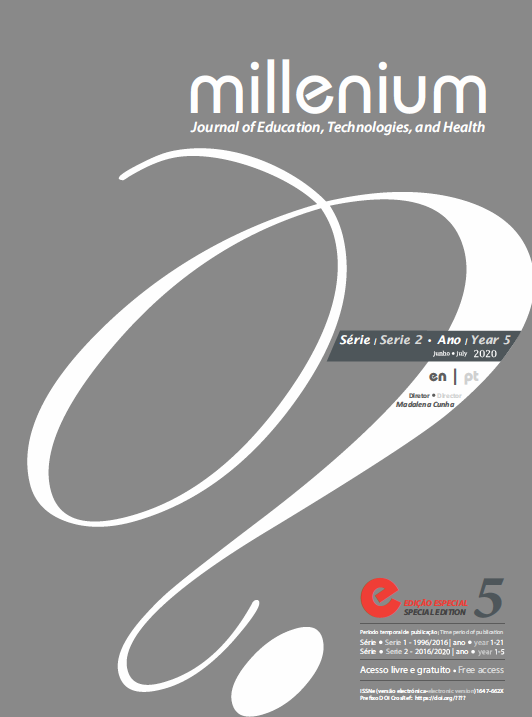El enfermero pre-hospitalario
cuidar para la cura
DOI:
https://doi.org/10.29352/mill0205e.14.00333Palabras clave:
enfermería, atención prehospitalaria, liderazgo, servicios de enfermeríaResumen
Introducción: La presencia de enfermeras en el contexto pre-hospitalario portugués se remonta a 1981. En 2007 se crearon las Ambulancias de Soporte Vital Inmediato del Instituto Nacional de Emergencias Médicas, en las que las enfermeras asumieron el papel de líderes de equipo. Esta reflexión tiene como objetivo analizar el papel de las enfermeras en la asistencia prehospitalaria.
Desarrollo: El contexto prehospitalario presenta fuertes desafíos para la enfermería y su identidad profesional. Las enfermeras llevan a cabo sus intervenciones y toman sus decisiones de acuerdo a la mejor evidencia científica, siguiendo protocolos terapéuticos predefinidos. Como líderes del equipo de socorro, son responsables de la gestión de los diferentes actores que proporcionan cuidados prehospitalarios, garantizando la seguridad de la atención sanitaria. Las personas socorridas en el prehospital esperan de los enfermeros la garantía de su supervivencia, y también, durante la asistencia, se preservan los cuidados, estrechamente ligados a la esencia de la enfermería. La producción y difusión de conocimientos científicos contribuirá a la optimización de todas las prácticas autónomas e interdependientes.
Conclusións: La función de la enfermera prehospitalaria se basa en tres puntos fundamentales: la administración de los cuidados de enfermería en el proceso de curación/salud; la aplicación de metodologías de gestión de riesgos y la elaboración de estrategias de gestión para la seguridad del socorro; la promoción de la investigación en la prestación de cuidados de emergencia que contribuyan al mejoramiento de los cuidados de enfermería. La difusión de conocimientos que respalden las prácticas actuales en el contexto prehospitalario ayudará a comprender la importancia de la participación de la enfermería en el marco de la emergencia y a afirmar la indispensabilidad e irreemplazabilidad de su intervención en el contexto prehospitalario.
Descargas
Citas
Alarhayem, A. Q., Myers, J. G., Dent, D., Liao, L., Muir, M., Mueller, D., & Eastridge, B. J. (2016). Time is the enemy: Mortality in trauma patients with hemorrhage from torso injury occurs long before the "golden hour". Am J Surg, 212(6), 1101-1105. DOI: 10.1016/j.amjsurg.2016.08.018.
Bandeira, A. G., Witt, R. R., Lapão, L. V., & Madruga, J. G. (2017). The Use of a Methodological Framework in the Implementation of Evidence as Part of Nursing Research. Texto Contexto Enferm, 26(24):e2550017. DOI: https://doi.org/10.1590/0104-07072017002550017.
Correia, T. S., Martins, M. M., & Forte, E. C. (2020). Nursing Management: Strategies for Client and Professional Safety. Millenium, 2ª Série, 11, 73-80. DOI: https://doi.org/10.29352/mill0211.08.00264.
Geovanini, T., Moreira, A., Schoeller, S., & Machado, W. (2019). História da Enfermagem: Versões e Interpretações (4 ed.). Rio de Janeiro: Thieme Revinter Publicações.
Instituto Nacional de Emergência Médica, I. N. E. M. (2017). INEM: História do INEM. Acedido a 17 de abril de 2020 em https://www.inem.pt/category/inem/o-inem/.
Magalhães, J. (2014). Competências na Intervenção de Enfermagem em Contexto Extra-Hospitalar - Cuidados de Emergência e Gestão de Situações de Exceção (Tese de Mestrado). Disponível no Repositório Científico do Instituto Politécnico de Viana do Castelo.
Ministério da Saúde, M. S. (2014a). Despacho n. 10319/2014. Diário da República n.º 10319/2014, 2ª Série – N.º 153 de 2014-08-11.
Ministério da Saúde, M. S. (2014b). Despacho n.º 5561/2014. Diário da República n.º 5561/2014, 2.ª série — N.º 79 — 2014-04-23.
Mota, M., Cunha, M., Santos, M. R., Cunha, I., Alves, M., & Marques, N. (2019). Pre-Hospital Nursing Interventions: Narrative Review. Enferm. Foco, 10 (4), 122-128.
Nilsson, J., Johansson, S., Nordstrom, G., & Wilde-Larsson, B. (2020). Development and Validation of the Ambulance Nurse Competence Scale. J Emerg Nurs, 46(1), 34-43. DOI: 10.1016/j.jen.2019.07.019.
Oliveira, A., & Martins, J. (2013). Being a nurse in Immediate Life Support: meaning of Experiences. Revista de Enfermagem Referência, III Série, 9, 115-124. DOI: http://dx.doi.org/10.12707/RIII1287.
Ordem dos Enfermeiros, O. E. (2007). Enfermagem no pré-hospitalar: Orientações relativas às atribuições do enfermeiro no pré-hospitalar. Acedido a 16 de abril de 2020 em http://www.ordemenfermeiros.pt/tomadasposicao/documents/enunciadoposicao17.
Rodrigues, L. M., & Martins, C. C. A. (2012). Vivências dos enfermeiros ao cuidar do doente crítico durante o transporte marítimo. Pensar Enfermagem, 16, 26-41.
Sherman, R. O., Bishop, M., Eggenberger, T., & Karden, R. (2007). Development of a leadership competency model. J Nurs Adm, 37(2), 85-94. DOI: 10.1097/00005110-200702000-00011.
Silva, E., Tipple, A., Souza, J. T., & Brasil, V. V. (2010). Historical aspects of the implantation of a prehospital care service. Rev. Eletr. Enf., 12(13):571-577. DOI: http://dx.doi.org/10.5216/ree.v12i3.10555.
Silva, V. L., Camelo, S. H., Soares, M. I., Resck, Z. M., Chaves, L. D., Santos, F. C., & Leal, L. A. (2017). Leadership Practices in Hospital Nursing: A Self of Manager Nurses. Rev Esc Enferm USP, 51, e03206. DOI: 10.1590/S1980-220X2016099503206.
Soren, S., Linda, W., & Veronica, L. (2015). Development of the Pre-hospital Emergency Care, The Registered Nurses' Role in the Ambulance Service- A Swedish Perspective. Emergency Med, 6(1), 294. DOI: 10.4172/2165-7548.1000294.
Watson, J. (2017). Clarifying the discipline of nursing as foundational to development of professional nursing. Texto Contexto Enferm, 26(24):editorial. DOI: https://doi.org/10.1590/0104-07072017002017editorial4.
Descargas
Publicado
Cómo citar
Número
Sección
Licencia
Los autores que sometan propuestas para esta revista estarán de acuerdo con los siguientes términos:
a) Los artículos serán publicados según la licencia Licença Creative Commons (CC BY 4.0), conforme el régimen open-access, sin cualquier coste para el autor o para el lector.
b) Los autores conservan los derechos de autor y conceden a la revista el derecho de la primera publicación, se permite la divulgación libre del trabajo, desde que sea correctamente atribuida la autoría y la publicación inicial en esta revista.
c) Los autores están autorización para firmar contratos adicionales separadamente, para la distribución no exclusiva de la versión del trabajo publicada en esta revista (ej.: publicar en un repositorio institucional o como capítulo de un libro), con reconocimiento de la autoría y publicación inicial e esta revista.
d) Los autores tienen permiso y son alentados a publicar y distribuir su trabajo on-line (ej.: en repositorios instituciones o en su página personal) ya que eso podrá generar alteraciones productivas, así como aumentar el impacto y la citación del trabajo publicado.
Documentos necesarios para la sumisión
Plantilla del artículo (formato editable)





